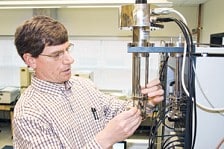Better batteries could store renewable energy

.floatimg-left-hort { float:left; } .floatimg-left-caption-hort { float:left; margin-bottom:10px; width:300px; margin-right:10px; clear:left;} .floatimg-left-vert { float:left; margin-top:10px; margin-right:15px; width:200px;} .floatimg-left-caption-vert { float:left; margin-right:10px; margin-bottom:10px; font-size: 12px; width:200px;} .floatimg-right-hort { float:right; margin-top:10px; margin-left:10px; margin-bottom:10px; width: 300px;} .floatimg-right-caption-hort { float:left; margin-right:10px; margin-bottom:10px; width: 300px; font-size: 12px; } .floatimg-right-vert { float:right; margin-top:10px; margin-left:10px; margin-bottom:10px; width: 200px;} .floatimg-right-caption-vert { float:left; margin-right:10px; margin-bottom:10px; width: 200px; font-size: 12px; } .floatimgright-sidebar { float:right; margin-top:10px; margin-left:10px; margin-bottom:10px; width: 200px; border-top-style: double; border-top-color: black; border-bottom-style: double; border-bottom-color: black;} .floatimgright-sidebar p { line-height: 115%; text-indent: 10px; } .floatimgright-sidebar h4 { font-variant:small-caps; } .pullquote { float:right; margin-top:10px; margin-left:10px; margin-bottom:10px; width: 150px; background: url(http://www.dmbusinessdaily.com/DAILY/editorial/extras/closequote.gif) no-repeat bottom right !important ; line-height: 150%; font-size: 125%; border-top: 1px solid; border-bottom: 1px solid;} .floatvidleft { float:left; margin-bottom:10px; width:325px; margin-right:10px; clear:left;} .floatvidright { float:right; margin-bottom:10px; width:325px; margin-right:10px; clear:left;}
This battery would make the Energizer Bunny hang his head and shut it down for the night.
But we’re not talking about the double-A batteries in your TV remote. We’re talking a much different type of battery of a much different size. Think bigger. Much bigger. The size of a large building big.
Imagine a sort of rechargeable lithium- or sodium-based battery that in conjunction with a wind turbine or solar panels could harvest energy, store it, and allow cities to draw upon its stored electricity at times when the wind fails to blow and the sun refuses to shine.
If you ask Steve Martin, an Anson Marston distinguished professor of engineering at Iowa State University, he’d say a battery of this nature is not only possible in the future, but necessary for the success of renewable sources of energy, and a direction the United States should have been going long ago.
Martin, who’s been involved with batteries for 30-plus years, is working to help advance electrochemical energy storage technology for batteries by way of two grants, one from the National Science Foundation and another from the U.S. Department of Energy through the local Ames Laboratory.
The problem Martin is trying to tackle has to do with the fundamental problem with renewable energy sources such as wind and solar: The wind doesn’t always blow and the sun doesn’t always shine when we need the energy most.
“There are what we call temporal mismatches between the availability of power from these renewable energy harvesters,” Martin said. “What you want to do is take the energy off of the maximums when we generate it with wind, store it, and then use it when you have the maximum need.”
There are other ways besides batteries to store energy. One method uses large water reservoirs at different elevations. When the wind blows, the electricity produced by wind turbines powers pumps that move water from the lower reservoir to the reservoir at a higher elevation. Then when electricity is needed later, the water is released and run through turbines that generate new electricity.
Problem is, finding two reservoirs at different elevations isn’t always the easiest task. Enter the more flexible electrochemical energy storage.
Keeping the reservoir idea in mind will help in understanding how the battery method works.
Think of this massive three-level battery as being dead, in a discharged state, or as in the case of the reservoir, think of all the water being at the lower elevation. When you hook the battery up to a wind turbine, for example, the electricity drives a chemical reaction that results in the battery entering a charged state, the equivalent of the water being pumped to the higher elevation. A similar function on a smaller scale is the act of charging a near-dead cell phone to a full charge. Now the energy is stored for use at a later date.
The chemical reaction naturally wants to run, and like water running down a hill, the reaction is run electrochemically so that the energy given off is in the form of electrical energy.
Regular single-use batteries by comparison come in a charged state, and once the chemical reaction runs, the batteries can’t be driven back uphill to a charged state.
Much of the work done by Martin and his colleagues in the battery field has been fundamental science related to the parts of a battery, Martin said, because the federal government hasn’t been very interested in funding the less sexy area of applied studies in batteries.
“Research is often incremental, and so we are not going to kind of reinvent the wheel,” Martin said.
“We are just going to solve problems in current batteries so we can apply them to large energy storage systems.”
Martin has been working on one of the three main components of a battery called the electrolyte, which is essentially the separator between the anode and the cathode, or the high reservoir and the low reservoir. The electrolyte plays an important role in forcing the reaction to run electrochemically, and Martin has been researching different types of electrolyte materials for different batteries.
But of late, Martin said, there has been a boom in the demand for better batteries for things like cell phones and cars, and funding is beginning to flow for applied research involving actually building batteries.
Lithium, he said, could be used for large batteries, but because lithium is so light and is not particularly abundant in the United States, there is a great demand for its use in portable electronics and car batteries.
“And so what we are trying to do is move to lithium-like batteries but batteries made of sodium instead of lithium,” Martin said.
Sodium solid-state batteries could be safer and cheaper than lithium batteries because of sodium’s abundance – it’s found in oceans and salt mines – and the cheapness of the material.
“It is too heavy, really, to be used for portable electronics and automobiles,” Martin said.
“But if you are doing load leveling like a big building, well you don’t move it. You put it there and it just stays and you never have to move it.”
There have also been some leakage problems with lithium batteries, which have liquid in them. Solid-state sodium-based batteries wouldn’t have liquid that could leak.
“That is a nuisance when you are working with small batteries, but it is not a real big problem,” Martin said. “But if you have a big building full of leaky liquid batteries, that is a big problem.”
Martin’s hope is to develop some new patents, because he feels that the chemistry he and his colleagues are working on is flexible enough to affect portable electronics, vehicles and energy storage.
Martin would also like to get some interest in licensing the technology to an established battery company or even a start-up in Iowa.
The latter appeals to Martin, who said that the United States is basically playing catch-up to nations such as China, Korea and Japan, which make virtually all of the lithium batteries that are commercially bought, even though the technology was originally developed in this country.
“Well, the concern is, if we in the United States don’t get our act together and solve this battery problem, we are going to just turn right back around and instead of spending $800 billion on crude oil, we are going to send $2 trillion to China and Japan and Korea on batteries,” Martin said. “So it is an issue, I think, of fundamental national security.”
Martin believes that making better batteries could be vital to our future as a country. And that’s why after 30 years, he’s hoping his research can keep our country going and going and going.
Sorry, Energizer Bunny.








